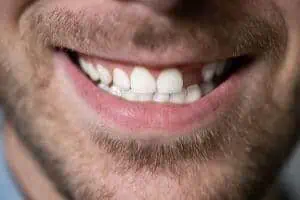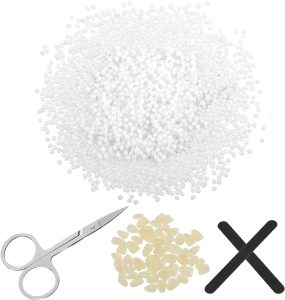If you’re missing a tooth and need to fill the gap until you can get a more permanent solution, you may want to consider a flipper tooth. It’s a removable denture generally used as a temporary replacement for a single missing tooth.
Dental flippers are one of the least invasive tooth replacement options. They are partial removable dentures that consist of an acrylic gum-coloured plate with a single prosthetic tooth or teeth attached.
Missing teeth can affect your confidence as well as your dental health, so it’s important that you fill the space with a replacement tooth, even temporarily while you wait for a permanent solution.
If you want to know a little bit more, keep reading while we cover everything you need to know about this type of denture and answer the following questions:
- What is a flipper tooth?
- Who can have a dental flipper?
- How much do they cost?
- What are the pros and cons?
Keep reading to find out if this is the best option for you!
What is a dental flipper?

A single tooth flipper is a removable partial denture generally used to replace just one missing tooth. Many dentists will use a flipper tooth as a temporary replacement while you wait for a more permanent solution such as a dental implant. You may also see them referred to as temporary dentures, flipper dentures or dental flippers.
Usually, a dental flipper looks like a small acrylic gum-coloured denture with a prosthetic tooth attached. Sometimes they can have metal or acrylic clasps that attach to your remaining natural teeth for support.
Why would you need a flipper tooth?
Replacing missing teeth due to disease, decay, or damage is often a lengthy process. When a tooth is extracted, the gums and the bone beneath it become sensitive and require at least six weeks to over six months to completely heal before you can get a permanent replacement.
Losing your natural teeth can change the shape of the bone structure of the jaw as well as the underlying gum tissue. These changes can negatively affect the fit of permanent dental implants or dentures meant for long-term wear. Wearing a temporary denture can reduce the changes in your mouth and prevent your remaining natural teeth from moving around.
What is a flipper tooth made of?
A flipper tooth is usually made of pink acrylic that can be matched to the exact colour of your gums. Depending on your dental needs, the flipper tooth may or may not have metal clasps or brackets made from metal to help secure it.
The acrylic structure attaches to your natural teeth on either side of the empty space left behind by your missing tooth. This makes it extremely easy for you to remove and put it back at any time you want and makes it easier to clean.
The following video shows how a natural tooth is extracted and replaced with an acrylic flipper tooth:
Should you use dental flippers?
As mentioned above, your dentist may suggest a dental flipper to temporarily replace a missing tooth so you needn’t wait long to fill the gap in your smile. But, should you actually get one? Let’s take a look at the benefits and drawbacks of these false teeth to help you make an informed decision.
Benefits of a dental flipper

- Better appearance: Dental flippers fill in the gaps caused by missing teeth so you can regain confidence in your smile.
- Advance preparation: If for some reason your dentist needs to extract one of your teeth due to disease or damage, a dental flipper can be prepared before the extraction and placed as soon as possible.
- Regain function: With a flipper, you may find it easier to chew or speak.
- More stability: Wearing a front tooth flipper can help to keep the surrounding remaining teeth in place and stop them from shifting positions.
- Convenient: Dental flippers are easy to wear and can be taken out for cleaning.
- Comfortable: This type of temporary denture is much more comfortable than some alternatives.
- Affordability: A flipper denture is generally cheaper than other tooth replacements.
- Easy to prepare: Dental flippers are made quickly, generally requiring one to two days on average. If you are waiting for an implant, flippers can be a good alternative in the meantime.
Drawbacks of a dental flipper
- Durability: Most dental flippers are made using cheaper materials that are less durable when compared to other types of dentures. This means they are more prone to cracking and breaking.
- Initial discomfort: Flipper teeth may initially feel uncomfortable in your mouth. This can also make activities like eating and talking feel slightly unnatural. If your flipper causes you pain or discomfort, consult your dentist.
- Potential allergy: Some people experience an allergic reaction from the material used to make flipper teeth. Discuss your allergy history with the dentist prior to getting one.
- Maintenance: Using flipper teeth can be harmful to your dental health because they increase the risk of tooth decay and gingivitis, especially if you do not clean them well.
- Risk of gum recession: A flipper tooth covers your gums entirely, hindering the flow of saliva to that particular area. Because saliva helps keep the gums clean and prevents recession, using a flipper tooth can actually increase this risk.
- Risk of Loosening: A flipper tooth is made and molded in such a way that it grips your existing teeth perfectly. However, using it over a long period of time can cause the denture to loosen. In this circumstance, you need to schedule an appointment with your dentist to fix it.
The following table summarises the main pros and cons of having a temporary flipper.
Pros | Cons |
Affordable | Increases risk of gingivitis and tooth decay |
Quick to make | Not always a perfect fit |
Can improve your smile | Easily damaged or broken |
Easy to remove for cleaning | Temporary |
Now that you’re armed with information, you can have a more informed discussion with your dentist about whether to get a flipper false tooth.
Flipper tooth cost
The cost of a temporary dental flipper is fixed with the NHS, however many people complain that their NHS dentures don’t fit as well as they would like. If you are interested in learning more about NHS charges you can check out our article here.
If you opt for private treatment the cost of a flipper tooth depends on what materials your dentist and the dental lab uses and how many teeth are being replaced (single tooth flipper, double tooth flipper, etc.). Costs can also vary between dentists and from dental practice to practice, but the cost of a partial denture can range from £200 to £2000.
Temporary dentures are generally more affordable than other types of dentures though so a flipper tooth cost may be on the more affordable end of the scale. However, we do recommend shopping around if you choose private treatment.
Dental flipper vs partial denture
A flipper tooth is essentially a partial denture, but the term flipper generally refers to a single tooth denture and a partial denture refers to a denture for more than one missing tooth.
The main difference between the two is that a flipper tooth is a temporary denture that you wear while you wait for a more permanent solution. A partial denture, whether it’s for one or more missing teeth, is a more permanent tooth replacement.
How to make a dental flipper at home

If you need to replace a missing tooth for a very short period of time until you can see a dentist, there is a way to make a dental flipper at home. This should only be used for a couple of hours to a day at the most. If you are concerned about your appearance it may be of help, whether you have lost a tooth through injury or you have accidentally broken your denture.
There are a few different options that you can find on Amazon, but they are all similar. They usually include beads that you meltdown to create the tooth that you need. Then you file it down and polish it, ready to be inserted into the gap that needs to be filled.
These temporary tooth kits are not made to be used for a permanent or even a long-term temporary fix, so make sure you read the instructions and follow the manufacturer’s guidelines. The replacement tooth that you make will probably not look overly realistic but it may help your self-confidence until you can get to a dentist.
Conclusion
A dental flipper is an affordable temporary prosthetic tooth replacement if you have lost a tooth through injury or decay. If you’re waiting for a more permanent tooth replacement solution, a flipper tooth might be a good choice for you.

Flipper teeth make it easier to eat and talk while you wait for a permanent replacement, and they also fill gaps in your smile if you’re worried about how you look. However, they aren’t perfect and they do have their drawbacks. They are often not as durable and can be prone to breaking, and you must be vigilant about your oral hygiene as they can potentially increase the risk of gingivitis and tooth decay.
However, with proper care and adherence to your dental hygiene routine, a flipper tooth is beneficial and convenient. Ultimately, your dentist will be able to help you decide if a flipper is right for you and can give you some alternatives as well.
FAQs
How long after extraction can I wear a flipper?
It is advisable to refrain from wearing your dental flipper tooth after extraction for 24 hours. However, your dentist will give you specific instructions for your individual case.
Can you eat with a dental flipper?
A flipper is designed primarily for aesthetics, but most patients learn to eat with their flippers in place. You should begin by chewing relatively soft food that is cut into small pieces.
Take small bites, and chew on both sides of your mouth at the same time. Hard or chewy foods (raw vegetables, french bread, etc.) should be avoided until after your period of adjustment.
Is a flipper the same as a partial denture?
Yes. Dental flippers are a type of partial denture used to act as a temporary filler for a gap in the tooth line. They are normally used to replace one missing tooth. Partial dentures, in general, can be used to replace one or multiple teeth.
How long can you wear a dental flipper?
Dental flippers are meant for temporary wear, usually just as long as it takes for your gums to heal before your implants. You may be able to wear them for longer, but only if your dentist gives the OK.
Flippers may also be worn by minors until they are old enough for implants, but regular denture care is required to keep them clean and prevent breakage.
What’s the best way to clean dental flippers?
When you take your flippers out at night, rinse them with water and gently brush them with a soft-bristled toothbrush. You can soak them in a denture cleaning solution and then overnight in water. Make sure you follow your dentist’s instructions with your particular denture, as some cleaning solutions can damage certain types of dentures.
European journal of dentistry: Allergic effects of the residual monomer used in denture base acrylic resins. Consulted 12 January 2022.
The journal of advanced prosthodontics: Immediate fixed partial denture after tooth extraction in patients with systemic diseases. Consulted 12 January 2022.




